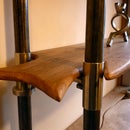Introduction: Rustic Garden Bench With Chainsaw
Welcome friend!
A giant poplar tree fell on my neighbours house in a storm. They were kind enough to let me saw it up into boards using my DIY chainsaw mill. To say thank you I wanted to make them a garden bench. If you're curious to see how that worked out then welcome aboard this Instructable, where I'll share the funky woodworking techniques I used and some of the lessons I learned.
If you want to know how to make a chainsaw mill, and loads of info on saw, chain sharpening, safety, technique, etc, etc. Check out my very comprehensive instructable on the subject here: https://www.instructables.com/id/Chainsaw-Mill-Build-Use-Tips-n-Tricks/
Step 1: Choose Your Logs
Our bench design evolved out of ANOTHER wind felled tree: a fence crushing oak that needed sawing up and clearing from a field. Oak makes an excellent choice for outdoor furniture because it's durable, which is to say the tannins in oak's heartwood make it very resistant to insects and fungus and it will not rot anything like as fast as a wood like poplar or ash, even when out in the elements.
As you will see we use four main big bits of timber in this project:
- Two side pieces - these are sawn from the part of the tree where one large branch forks into two. This 'crotch' piece, as it's known, is a section of the tree that would normally be reserved for firewood at commercial sawmills, being not straight, awkward to bandsaw and difficult to store.
- The back rest - this is made from a long ~6ft curved branch.
- The seat - made from the same 6ft curved branch.
Step 2: A Word About Tools, Method and Safety
This project uses the chainsaw (CS) mill I made some time ago - here's a complete instructable about making and using your own CS mill.
There is something truly special about going all the way from a fallen tree to a finished piece of furniture. Compared to buying box-store lumber you can make something in a different league. OK well, 'different' - I'm not dissing the whole 2x4 this or that - standardised wood's really cool for some projects and circumstances (and actually kinda hard to achieve from DIY milled wood). So we want to play to the strengths of being there at the beginning - when the lumber is first made. It does pose some unique considerations which I'll get to as we go, but for the rest of this step lets look at keeping happy and healthy, and what tools we need:
Safety
Safety is obviously important whenever you are using a chainsaw, and having already written a whole section on that in the instructable above, I will mention only a few points here:
1. Keep the chain brake on all the times you are not actively cutting.
2. Triple check the log is stable, cannot roll, and that the straight edge (in our case a ladder), is secure before you begin.
3. Much of the risk with chainsaw milling occurs BEFORE and AFTER the actual sawing! Be mindful of how you transport heavy slabs once cut, and how you manoeuvre the log into position ready for milling.
4. Don't ignore personal safety equipment! For milling on days without a stiff breeze, a duel vapour-dust mask as you see in the pics should be considered a requirement, not a nice-to-have. Milling is different to the normal use of a chainsaw - you are standing in a cloud of fine dust and chainsaw fumes for much longer.
Tools
- I am using an MS880 saw with the chainsaw mill attachment.
- Chainsaw mill toolbox - including PPE, wedges, drill, fixings, scrench etc. See "Step 10: Milling Check List" in the instructable linked to above for the whole deal
- Circular saw with straight edge, or a plunging track-saw (like I use). You can of course do this project without it, using traditional methods.
- Hammer and chisel.
- A heavy duty ratchet strap is handy for assembly.
- Long decking screws - again you could go traditional and pin it with wooden dowels.
Step 3: Cut Up the Bench's Sides
A nice wide crotch piece is really good for the sides. If we slice through it with the mill, you normally reveal a wonder of swirling, interlocking grain patterns. The additional width at the fork gives us a place to mount the bench's seat, while the lesser of the branching off bits can make for a nice arm rest.
Setting up the straight edge (ladder) on such a log can be tricky, but is usually quite possible, and the shape of the log has the advantage that it is normally quite stable. For more info and tips check the photo notes.
Step 4: Three Often Ignored Milling Tips
We wanted to keep the bark on for this one, because it looks cool - at least for a little while until the ravages of nature (and children) tear it from the bench. Anyway, if you're not de-barking before milling, it is worth giving it a very good brush down to remove any potential dirt and grit from the surface, which would quickly dull the chain.
Use the wedges with care. Lots of people hammer them in, but that tends to move the straight edge, leaving big gouging chain marks. So instead just push them in just tight enough (it will vary depending on how big/long the log is.
Assuming your saw has the power, a longer guide bar is better, even on not so big logs. The chain lasts longer between sharpening, and the guide bar and chain run cooler. More importantly you can run the mill at an angle through the log, In my experience this makes for a smoother finished board, slightly less dusty sawdust, and a mill that wants to move along the cut buy itself (less pushing).
Step 5: Mill Up the Seat and Back Rest
We wanted the back rest to arch like a rainbow and the seat to curve round, in an inclusive, pro-social, give-you-a-hug style. Therefore we need a curved branch to mill from. There is usually no shortage of these, indeed a lack of straight timber is the common conundrum.
Make sure to get the straight edge set up so you get the boards in the curved manner you desire and mill away. I'm milling them to 3" for a super chunky 'last a lifetime' kinda feel.
Step 6: Dealing With Slabs and Transportation
If you make a bench of the same kind of size you will want help carrying the slabs. Whether the help is friends, or machines, or friendly machines, it's much easier to get help! Oh, and plan your route, clear a path and all that 'common sense' stuff that tends to slip when your excited or tired.
Step 7: Carefully Consider Your Design and Angles
Having two curved slabs for the back and bench means you need to think about how laid back you want the back to be. A more relaxed back angle is great for the very chilled out among us.
Aesthetically we wanted to make this so that the sides sloped outwards, so that the sides were more than 90 degrees to the ground. We also made it so the sides were 'open faced', as in they are angled outwards. It's much more complicated to construct that way, than if you made the whole thing perpendicular, but having it that way is cool as...
Do some sketches, have a head scratch and work out how you want your bench to be based on where it's likely to be situated, what the timber is like, and who's going to end up using it!
Step 8: Cut the Angles and Rough Sizes
What you decided on in the previous step will influence how you cut the slabs to size. Making this one I drew a long straight line down the length of the seat and the back. This was like the 'line of best fit' and what we measured and marked all our angles from.
As you will see from photos and their notes, the slabs were thick enough that we couldn't easily cut through them with the circular saw. I often deal with this problem by cutting at max depth from both sides and then cutting the remaining wood with a handsaw. Cutting from both sides, may not be as straightforward as it seems when neither of the edges are square or straight because you can use a square to mark across the edge of the board. A little trick to get round this is to use a long thin drill bit to continue the saw cut from the first face to the underside. Do that at either and of the cut, flip the board over and mark your saw line between the two holes. Not a super accurate way of doing it, but good enough for a job like this.
Step 9: Mortise #0 Mark Up the Mortises
There's many different ways to do mortise and tenon joints, for this project we went with making the mortises first, partly because we were making them the full thickness of the seat slab. The seat -side joints are probably more accurately called stopped dados, as you will see...
Either way, the ones in the back are certainly mortise and tenons. If you want to follow along, mark up the mortises on the side pieces based on the angles you calculated. We made the mortises slightly less long than the slab's width, so there would only be little notches to cut off the back and seat.
Step 10: Mortise #1: the Circular Saw Method
To remove most of the material, I used the old circular saw and guide method. Line the saw guide up with the mortise and cut away. We want to make lots of slots so that the remaining pieces will easily brake away. I keep them, as they make excellent fire starting material once dry).
As a note of caution, be very careful with the plunging and the small amount of reverse cutting needed on the seat's back-mortises. I would only recommend this when using the saw on a guide so it can only move forwards and back, and you have your whole body weight behind the saw, controlling it firmly.
I recommend cutting the mortise width slightly shy of the final thickness - we can finish it better later.
Step 11: Mortise #2: Chisel Out the Waste and Square Off the Corners
If your lucky, or have forethought, you will have chainsaw milled the boards to the thickness of your favourite chisel, and can now use that to cleanly cut away the waste, flatten the mortise bottoms and square up the corners.
Step 12: Mortise #3: Finalise the Dimension
With the waste removed it becomes clear if the board will fit well. As you undersized it you can now use the off cut you made in step 8. I then like to use the saw to fine tune the dimension so it's just right.
For this king of green wood joinery, where we are not using wood glue we can go a bit tighter than we might... If we were using glue a very tight joint tends to scrape all the glue out as it's being assembled.
Step 13: Mortise #4: Additions and Alt Methods
Just to show an alternative method: a way to get nice flat bottomed mortises is to use a router... Not going into this too much - just is an option if you have one
Step 14: Drill Your Decking Screw Holes
BEFORE you assemble, drill through the mortises to make holes for the decking screws. If you drill from the other side, if can be tricky to guesstimate where the holes go. It is very difficult to accurately measure because of the wiggly natural edge of the sides.
Step 15: Make the Tenons
The tenons on the seat just need squaring off on the back natural edge, so that it fits nicely into the mortise channel.
The back rest being a half round requires a bit more more, requiring we flatten the circular part to form a standard tenon.
Step 16: Double Check the Back Rest Lengths
because of the complicated compound angles involved we assembled the bench with just the seat, and measured the physical distance the back rest needed to be. Calculating the length with geometry is all good, but measuring the actuality is better if you can...
Step 17: Make the Legs
I must admit the 'legs', which are stabilising bits attached to the side pieces, were a bit of an afterthought. They are essentially two short 3x4" lengths of oak. They are fixed on in much the same way the seat was, using decking screws and a dado.
Don't do the final fix on these bits, untill you have transported the bench to where it will live, as they make moving quite a bit more tricky.
Step 18: Assemble Once??!
If you plan much better than me, you will be able to put it together once. I took several assemble, disassemble, fettle, reassemble cycles before I was happy.
Step 19: Test Out!
Even without any fasteners, it's easily strong enough if you did it right and don't have a party on the bench.
Step 20: Clamp Up With Ratchet Strap
To get everything super tight use a heavy duty ratchet strap.
If you don't have one you could also just use a rubber mallet or a rope and a Spanish windlass.
Step 21: Fix With Decking Screws
With it all tight lets lock it in place with some decking screws. You will probably want to counterbore the holes in the sides, so the decking screws bite into the back and seat enough.
Step 22: Sand Out the Marks If You Made Any
So personally I love the feel and look of chainsaw milled lumber... However we were a little shall we say, relaxed, about how we dealt with the boards, and muddy footprints turned into real black stains in the oak as the the tannins react.
Unless you like the footprint too, there isn't loads of options but to sand... :(
Step 23: Smoooth Off the Corners.
An optional step. I like to round off sharp corners.
Step 24: Deliver to the New Home
Time to take this one to the neighbours and see what they make of it ;)
We had a little mutant trolley-jack that we used to transport this epicly heavy beast. Care must be taken - its very heavy!
OK friends, hopefully you will find this interesting and it may act as inspiration and give you ideas for what you can do with green chainsaw milled lumber...
If you found some of that interesting, please do connect! Leave a comment below, share this with your maker- garden furniture loving friends, check out my YouTube channel FlowerinfElbow, subscribe to me here on instructables, and/or come see me on Facebook here.

First Prize in the
Furniture Contest 2018













